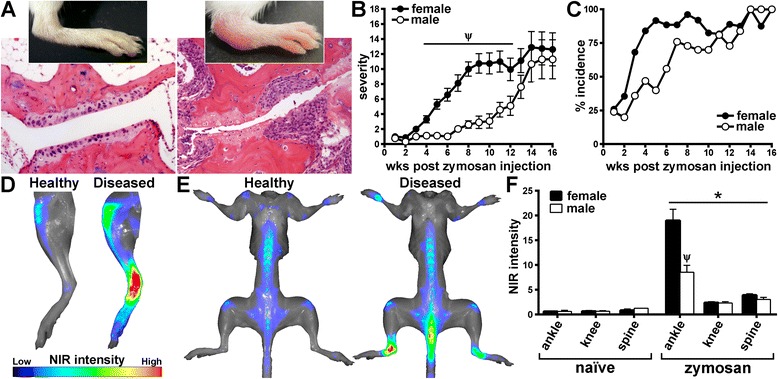Fig. 1.

Zymosan exposure results in chronic and progressive polyarthritis in SKG mice. SKG mice were administered a single intraperitoneal injection of zymosan at 7–8 weeks of age. Animals were subsequently evaluated clinically for arthritis every week to 16 weeks after zymosan injection (i.e., 23–24 weeks of age). a Representative photographs depict healthy, uninflamed ankle and digit within the ankle of a naive SKG animal (clinical grade 0, left) and an inflamed, arthritic ankle (clinical grade 4, right) of an SKG mouse that received a zymosan injection. Below the photographs are stained histopathological sections obtained at 16 weeks after zymosan injection. Clinical arthritis evaluation revealed increased severity and faster onset in zymosan-challenged females compared with males (b, c). Naive SKG mice of either sex did not show any arthritis development (data not graphed). d Visualization of deposition and activation of labeled near-infrared (NIR) probe within the legs at 16 weeks after zymosan injection. Knees and ankle and tarsometatarsal joints of legs obtained from a naive BALB/c mouse (Healthy) and an arthritic SKG mouse that had received zymosan injection (Diseased). e Whole-body NIR images illustrate changes to the base of the spine occurring at 16 weeks after zymosan injection in a diseased (after zymosan injection) SKG mouse (right) versus a healthy, naive BALB/c mouse (left). f Quantification of regions of interest of SKG mice using NIR imaging technology, wherein all values were normalized to background signaling from naive BALB/c mice. *p < 0.05 indicates effect of zymosan versus naive SKG mice; Ψ p < 0.05 sex comparison between SKG mice that received a zymosan injection; n = 12–18 mice/group (combined two individual experiments). A significant response was observed for both male and female mice that received zymosan injections compared with the non-treated group for onset and severity of arthritis (b, c)
